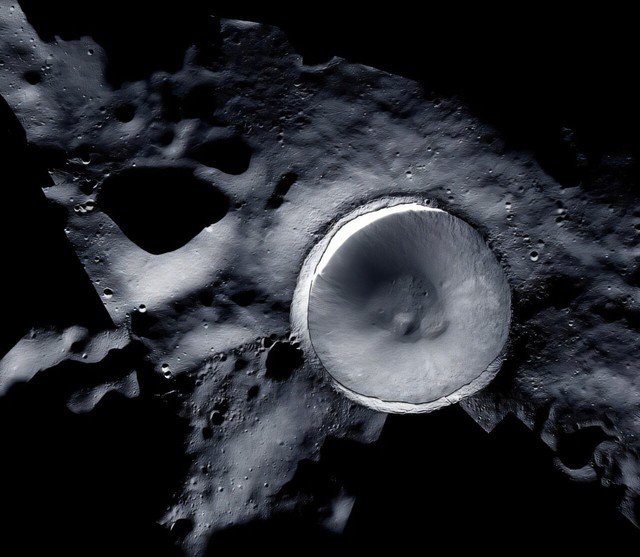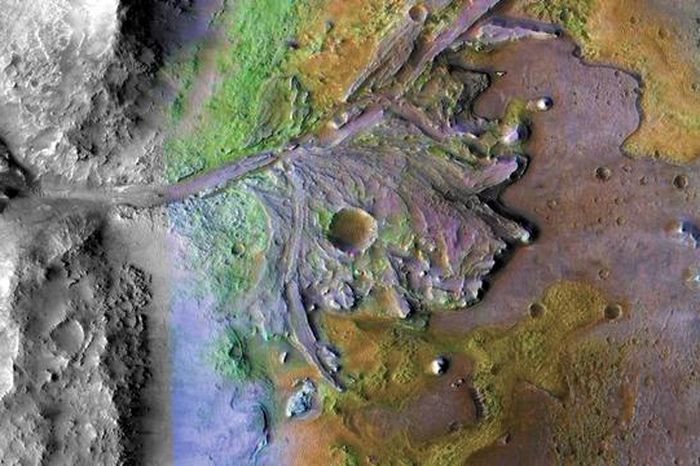Worrying news about where alien life might be hiding
A new study from the US and Canada has found that the 'shadow craters' at the Moon's poles could be teeming with life. And that's bad news.
These aliens may have originated from. Earth., related to the unexpected incidents.

Shackleton crater on the Moon in a brightened image - Photo: NASA
Inside the 'dark pits' is eternal darkness, because their angle means that light can never shine inside. But there are microorganisms that can thrive perfectly well in this environment.
Speaking to Universe Today, Associate Professor Dr. John Moores from the Center for Earth and Space Science Research at York University (Canada) said these "dark holes" have been overlooked in previous studies of life.
One of the main reasons for this omission is that modeling the ultraviolet radiation environment there is very complicated. However, a colleague of Professor Moores, Dr. Jacob Kloos from the University of Maryland (USA), found a way.
Using a sophisticated lighting model based on what spacecraft collected from two craters on the Moon, named Shackleton and Faustini.
They found that the lack of sunlight, combined with the Moon's lack of atmosphere and direct exposure to a vacuum, created "cold pockets" in which bacteria could survive.
But these alien creatures did not appear on the Moon by themselves, but were accidentally "seeded" by humans.
This biological contamination is caused by Earth's spaceships. As many studies have shown, some microorganisms are capable of hitching rides on spaceships, surviving the journey from Earth to this nearest celestial body.
"Bacteria in space are usually killed by high temperatures and ultraviolet radiation. But these craters are very cold and very dark, making them one of the most protective environments in the solar system for the types of bacteria that often cling to spacecraft," Associate Professor Moores explained.
This alien life may not be able to reproduce and grow into a large population in the harsh conditions of the Moon, but it could still continue to exist for decades until its spores are destroyed by the effects of the vacuum.
Contamination by alien life on a celestial body could hamper scientific missions, creating confusing data in the hunt for "native" life on that celestial body.
That concern is not unheard of. NASA has an 'Office of Planetary Protection,' which oversees the sterilization and cleaning of spacecraft before launch, as well as ensuring that returning spacecraft do not bring back alien microbes.
You should read it
- Discovering 'alien antenna' on the Moon?
- Doctor of Philosophy of Science: We may have discovered traces of aliens already, we just don't know what it is.
- Is the 'alien skeleton' found in Peru true?
- The project to search for alien life stopped working after 20 years
- 'Sudden death', the alien hunting ship still had time to leave behind its treasure
- Decipher the mysterious evidence of an alien encounter at Roswell in 1947
- Build a space telescope complex to serve the mission of finding aliens
- NASA robot enters the alien 'river of life'
May be interested
- Summary of the hottest technology news from February 1, 2015
 the 11-year-old facebook social network, 10 laptops with the best battery life, convert data from lumia to pc, office 2016 technical preview, hubert media will invest in coc coc, youtube tests video viewing feature a lot shooting angle ... are the most interesting news and tips of the week
the 11-year-old facebook social network, 10 laptops with the best battery life, convert data from lumia to pc, office 2016 technical preview, hubert media will invest in coc coc, youtube tests video viewing feature a lot shooting angle ... are the most interesting news and tips of the week - Is the 'alien skeleton' found in Peru true?
 join us to find out if the alien skeleton found in peru is real or not!
join us to find out if the alien skeleton found in peru is real or not! - If people 'occupy' the Sun 2.0 system, how different is life there from Earth?
 scientists at nasa have discovered 7 planets in the solar system 2.0 - trappist-1 is about the same size as the earth and is located in a region that can sustain life. assuming these planets can really sustain life, what will life on it be like?
scientists at nasa have discovered 7 planets in the solar system 2.0 - trappist-1 is about the same size as the earth and is located in a region that can sustain life. assuming these planets can really sustain life, what will life on it be like? - Top hideout Free Fire little known
 here are a few hiding places in free fire that gamers are easy to find and if not paying attention, you will not be able to see players hiding in it.
here are a few hiding places in free fire that gamers are easy to find and if not paying attention, you will not be able to see players hiding in it. - The lesson changes the concept of living and having the happiness from Zen Master Thich Nhat Hanh
 in life we sometimes have to face difficulties in finding ourselves peaceful and happy. sometimes, people spend too much time worrying about things that have or have not happened in life but forget about enjoying the present moments of this life.
in life we sometimes have to face difficulties in finding ourselves peaceful and happy. sometimes, people spend too much time worrying about things that have or have not happened in life but forget about enjoying the present moments of this life. - How to customize the News app on Windows 10
 the microsoft news app lets you view the latest news and headlines in one place. you can customize it to show the news that interests you, locally or worldwide, as well as hide news sources you don't like.
the microsoft news app lets you view the latest news and headlines in one place. you can customize it to show the news that interests you, locally or worldwide, as well as hide news sources you don't like. - How to Personalize Google News
 today's tipsmake will show you how to customize the google news page or app (google news). because google news relies on browsing history, you must manually delete or request to add specific topics/sources if you want to filter the news that appears on the news feed.
today's tipsmake will show you how to customize the google news page or app (google news). because google news relies on browsing history, you must manually delete or request to add specific topics/sources if you want to filter the news that appears on the news feed. - Summary of the hottest technology news in August 4
 discover how to hack smartphones via gmail, common errors and fixes on htc one m8, how to recognize bright open screen, save battery on android 4.4 kitkat, create animation on photoshop cs6 and then create account microsoft for windows phone, ... is the best news, tips are most concerned about last week!
discover how to hack smartphones via gmail, common errors and fixes on htc one m8, how to recognize bright open screen, save battery on android 4.4 kitkat, create animation on photoshop cs6 and then create account microsoft for windows phone, ... is the best news, tips are most concerned about last week! - Instructions for activating Apple News app on iOS 9
 being rated as one of the most attractive applications on ios 9, apple news integrates a large number of news pages in the same source, so changing from one page to another becomes simple and easier than ever to facilitate updating information.
being rated as one of the most attractive applications on ios 9, apple news integrates a large number of news pages in the same source, so changing from one page to another becomes simple and easier than ever to facilitate updating information. - 'Sudden death', the alien hunting ship still had time to leave behind its treasure
 nasa said that the alien hunter ingenuity has not really slept peacefully after 3 months of saying goodbye to humanity.
nasa said that the alien hunter ingenuity has not really slept peacefully after 3 months of saying goodbye to humanity.










 The US Air Force's secret weapon has just returned to Earth after 434 days
The US Air Force's secret weapon has just returned to Earth after 434 days Humanity Misunderstands the Code of Life on Mars?
Humanity Misunderstands the Code of Life on Mars? NASA discovers second Milky Way galaxy at the edge of the solar system
NASA discovers second Milky Way galaxy at the edge of the solar system Earth changes color after being caught in a giant cosmic wave
Earth changes color after being caught in a giant cosmic wave A terrifying object that made life on Earth evolve by leaps and bounds?
A terrifying object that made life on Earth evolve by leaps and bounds? Amazing Super Planet With Iron Winds, Ruby Rain
Amazing Super Planet With Iron Winds, Ruby Rain